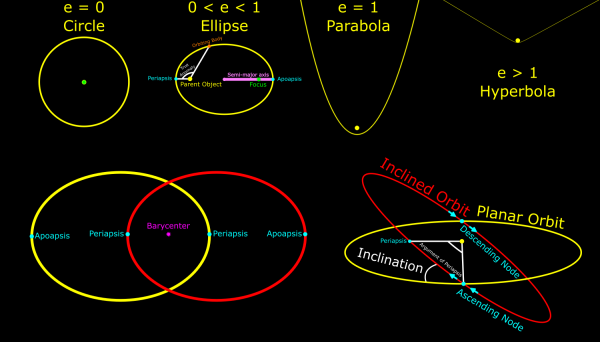BY LETTER
Orbital and Rotational Elements
Orbital Elements |
 Image from MiyuwiAuthor |
An ideal Keplerian orbit can be described by six parameters: semi-major axis, eccentricity, inclination, longitude of the ascending node, argument of periapsis, and mean anomaly.
Semi-major axis
Semi-major axis is one half of the longest diameter of the orbit, known as the major axis. In practice, the semi-major axis can be found by finding the mean of the distance of the object from the parent object's center at periapsis and apoapsis.Eccentricity
Eccentricity is the measure of how an orbit deviates from being a perfect circle. A perfectly circular orbit has an eccentricity of zero; an elliptical orbit an eccentricity between 0 and 1; a parabolic orbit an eccentricity equal to 1; and a hyperbolic orbit an eccentricity greater than 1.An eccentric orbit has apses, or points where the orbiting body is furthest or closest to the parent object, which is located at one of the foci.
Apoapsis, or apocenter, is the point at which two objects in an elliptical orbit around their centre of gravity are at their furthest from each other. Many derivative terms exist for different central bodies, such as apogee (Earth, or any planet in general), aphelion (Sol), apoastron (stars in general), or apomelasma (black holes).
Periapsis, or pericenter, is the point at which two objects in an elliptical orbit around their centre of gravity are at their closest approach. Like apoapsis, many derivative terms exist, such as perigee (Earth, or any planet in general), perihelion (Sol), periastron (stars in general), or perimelasma (black holes).
Inclination
Inclination is the angle between the plane of an orbit and the plane of reference of choice.Longitude of the ascending node
Longitude of the ascending node is the angle that the ascending node - one of the two points in the orbit which intersect the plane of reference where the object moves 'up' in the associated coordinate system when passing through it - makes with a given plane of reference's prime meridian, where longitude is defined as 0 degrees. This parameter is undefined if inclination is 0.Argument of Periapsis
Argument of periapsis is the angle from the orbit's ascending node to its periapsis. This parameter is undefined if eccentricity is 0.Mean Anomaly
Mean anomaly is an imaginary angle that advances uniformly in time, taking one orbital period to advance by 360 degrees - in effect, it encodes the length of time since the object in question last passed its periapsis. It is a common way to specify the position of the orbiting object at any given time.Miscellaneous terms related to orbits
Barycentre
Barycentre is the centre of mass around which a system of objects rotate. For example, Earth and Luna both revolve around their barycentre, which is 1703 km beneath the Earth's mean radius along the line between them. Pluto and its moon Charon revolve around their barycentre, which is 944 km above Pluto's mean radius along the line between them.Related Articles
- Geosynchronous Orbit (GEO) - Text by M. Alan Kazlev
Orbital distance from a planetary or other rotating body at which the orbital period matches the primary's rotational period. A satellite or other body placed at this distance remains near the same spot over the primary (over the equator). A geosynchronous orbit is circular and has zero inclination. There is only one geosynchronous orbit per celestial body. - Glossary
- Hohmann Transfer Orbit
- Orbital (habitat)
- Orbital (political unit) - Text by M. Alan Kazlev
Originally, a nation state or city state based on habitats in orbit around Old Earth. Over the course of the Interplanetary Age the term came to be used for any such state in Solsys. By early First Federation times the term Orbital was used more broadly for any independent or semi-independent state based on a hab in orbit around a planet. - Orbital Band
- Orbital League / Cislunar Alliance
Appears in Topics
Development Notes
Text by AstroChara
Initially published on 01 October 2024.
This article consolidates a variety of orbital mechanics vocabulary stub articles by M. Alan Kazlev, originally written on 2001-10-08
Initially published on 01 October 2024.
This article consolidates a variety of orbital mechanics vocabulary stub articles by M. Alan Kazlev, originally written on 2001-10-08






